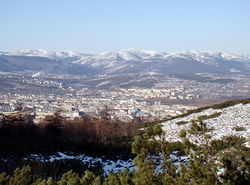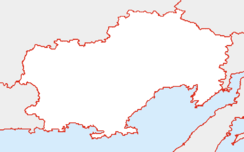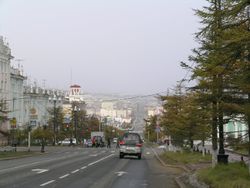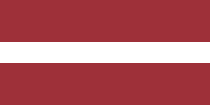Magadan
- Some old Greek Bible manuscripts have "Magadan" for one of the places in Palestine usually known as Magdala.
| Magadan (English) Магадан (Russian) |
|
|---|---|
| — Inhabited locality — | |
 Magadan seen from the local mountains |
|
.svg.png) Location of Magadan Oblast in Russia |
|
 Magadan
|
|
| Coordinates: | |
 |
 |
| Holiday | July 14 |
| Administrative status | |
| Country | Russia |
| Federal subject | Magadan Oblast |
| Administrative center of | Magadan Oblast |
| Municipal status | |
| Urban okrug | Magadan Urban Okrug |
| Mayor | Vladimir Pechyony |
| Representative body | City Duma |
| Statistics | |
| Area | 180 km2 (69 sq mi) |
| Population (2002 Census) | 99,399 inhabitants[1] |
| - Rank | 169th |
| - Density | 552 /km2 (1,430 /sq mi)[2] |
| Time zone | MAGT/MAGST (UTC+11/+12) |
| Founded | 1930s |
| Postal code(s) | 685000 |
| Dialing code(s) | +7 4132 |
| Official website | |
Magadan (Russian: Магада́н) is a port town on the Sea of Okhotsk and gateway to the Kolyma region. It is the administrative center of Magadan Oblast (since 1953), in the Russian Far East. Founded in 1929 on the site of an earlier settlement from the 1920s, it was granted the status of town in 1939. From 1932 to 1953 it was the administrative center of the Dalstroy concern and its corrective labor camp system. It lies in Nagayevo Bay in the Gulf of Tauisk. Population: 114,873 (2008 est.); 99,399 (2002 Census);[1] 151,652 (1989 Census).[3] Ship building and fishing are the major industries. The town has a seaport (fully navigable from May to December) and a small international airport, Sokol Airport. There is also a small airport nearby, Magadan 13. The unpaved Kolyma Highway leads from Magadan to the rich gold-mining region of the upper Kolyma River and then on to Yakutsk.
Contents |
History
In 1932, Magadan was made Dalstroy's capital, and served as a port for exporting gold and other metals mined in the Kolyma region.[4] Its size and population grew quickly as facilities were rapidly developed for the expanding mining activities in the area. Town status was granted on July 14, 1939.
During the Stalin era, Magadan was a major transit center for prisoners sent to labor camps. The operations of Dalstroy, a vast and brutal forced-labor gold-mining concern, were the main economic driver of the city for many decades during Soviet times.
Of the 12,000 Poles sent to Magadan and environs between 1940 and 1941, most POWs, only 583 men returned [5], released in 1942 to join the Polish free force of Polish II Corps under General Władysław Anders. WWII survivors became residents of the U.S., Britain and other countries.
In May 1944, U.S. Vice President Henry Wallace's official visit [6] failed to understand the true nature of Magadan. The watchtowers had been temporarily taken down and the prisoners were locked up, while a model farm was set up for his inspection.[7] He took an instant liking to his secret policeman host, admired handiwork done by prisoners, and later glowingly pronounced the city "a combination TVA and Hudson's Bay Company".[8]
Further details of this period are given in the article on Kolyma.
Economy
Magadan is very isolated. The nearest major city is Yakutsk, 2,000 kilometers (1,200 mi) away via an unpaved road which is best used in the winter, especially since there is no bridge over the Lena River at Yakutsk (the choices are: ferry from Nizhny Bestyakh in the summer, when rest of the road may not be passable due to standing water, or over the ice in the dead of winter).
The principal sources of income for the local economy are gold mining and fisheries. Recently, gold production has declined[9] although future prospects look good. Fishing production, although improving from year to year, is still well below the allocated quotas, apparently as a result of an ageing fleet.[10] Other local industries include pasta and sausage plants and a distillery.[11] Although farming is difficult owing to the harsh climate, there are many public and private farming enterprises.

Long Way Round
Magadan was the focal point of the Long Way Round motorcycle journey made by Ewan McGregor, Charley Boorman and their team. Although their ultimate destination was New York, they frequently noted how reaching the Russian city was the ultimate measure of success or failure for their adventure. Despite encountering swollen rivers, broken bridges and virtually impassable roads as they travelled through Siberia, they were ultimately able to ride the "Road of Bones" into Magadan, and flew from there to Anchorage, Alaska from where they continued to New York. Recalling his final day in Magadan before leaving for America, McGregor wrote:
- "Magadan, Siberia. The place that had been in my thoughts and dreams for two years, like a mythical city forever beyond my reach. I wanted to capture it, somehow hold on to it and take a part of it with me when we began the long journey home."
Culture

The city has a number of cultural institutions including the Regional Museum of Anthropology, a geological museum a regional library, and a university. The city has the enormous new Orthodox Cathedral Church of the Trinity, a recently completed Roman Catholic Church of the Nativity and the Mask of Sorrow memorial, a huge sculpture in memory of Stalin's victims, designed by Ernst Neizvestny.
Climate
The climate of Magadan is subarctic (Köppen climate classification Dfc). Winters are prolonged and very cold, with up to six months of sub-zero temperatures, so that the soil remains permanently frozen. Permafrost and tundra cover most of the region. The growing season is only one hundred days long. Average temperatures on the coast of the Sea of Okhotsk range from −22 °C (−8 °F) in January to 12 °C (54 °F) in July. Average temperatures in the interior range from −38 °C (−36 °F) in January to 16 °C (60 °F) in July.
Famous people
- Yelena Välbe (1968- ), an Olympic cross-country skiier. She competed in 3 Olympic games from 1992-1998 winning 7 medals including 3 Gold.
- Vadim Kozin (1903–1994), a popular Russian tenor in the 1930s. Sentenced to the Kolyma camps in 1944, he became a resident of Magadan where he died.
- Nikolai Getman (1917-2004), Ukrainian artist, remembered for his paintings depicting the horrors of the Kolyma gulag. He organized the Magadan Artists' Union and was director of the Magadan section of the Arts Foundation of the RSFSR from 1963 to 1966.
- Valentin Tsvetkov (1948-2002), former governor (from 1996) of Magadan Oblast, gunned down in Moscow in October 2002, apparently for issues involving fish quotas[12].
- Pavel Vinogradov was a Russian cosmonaut.
Sister cities
 Anchorage, United States.
Anchorage, United States. Jelgava, Latvia.
Jelgava, Latvia. Tonghua, China.
Tonghua, China.
Bibliography
- McGregor, E & Boorman, C: Long Way Round. Time Warner Books, 2004. ISBN 0-7515-3680-6
- David J. Nordlander: Origins of a Gulag Capital: Magadan and Stalinist Control in the Early 1930s, Slavic Review, Vol. 57, No. 4 (Winter, 1998), pp. 791-812
Footnotes
- ↑ 1.0 1.1 Федеральная служба государственной статистики (Federal State Statistics Service) (2004-05-21). "Численность населения России, субъектов Российской Федерации в составе федеральных округов, районов, городских поселений, сельских населённых пунктов – районных центров и сельских населённых пунктов с населением 3 тысячи и более человек (Population of Russia, its federal districts, federal subjects, districts, urban localities, rural localities—administrative centers, and rural localities with population of over 3,000)" (in Russian). Всероссийская перепись населения 2002 года (All-Russia Population Census of 2002). Federal State Statistics Service. http://perepis2002.ru/ct/html/TOM_01_04_1.htm. Retrieved 2009-08-19.
- ↑ The value of density was calculated automatically by dividing the 2002 Census population by the area specified in the infobox. Please note that this value may not be accurate as the area specified in the infobox does not necessarily correspond to the area of the entity proper or is reported for the same year as the Census (2002).
- ↑ "Всесоюзная перепись населения 1989 г. Численность наличного населения союзных и автономных республик, автономных областей и округов, краёв, областей, районов, городских поселений и сёл-райцентров. (All Union Population Census of 1989. Present population of union and autonomous republics, autonomous oblasts and okrugs, krais, oblasts, districts, urban settlements, and villages serving as district administrative centers.)" (in Russian). Всесоюзная перепись населения 1989 года (All-Union Population Census of 1989). Demoscope Weekly (website of the Institute of Demographics of the State University—Higher School of Economics. 1989. http://demoscope.ru/weekly/ssp/rus89_reg.php. Retrieved 2007-12-13.
- ↑ Козлов, А. Г.. Магадан. Конспект прошлого. Магаданское книжное издательство (1989) ISBN 5-7581-0066-8. p. 16.
- ↑ [1]
- ↑ [2]
- ↑ Tolstoy, Nikolai. The Secret Betrayal. Charles Scribner's Sons (1977) ISBN 0-684-15635-0. p. 133.
- ↑ [3]
- ↑ Russian gold mine production declined 4 tonnes in 2006, Mineweb, 31 January 2007
- ↑ New Russian Fishing Quotas Distribution System, Strategis international market reports, 28 August 2004
- ↑ Magadan Region from Kommersant, Russia's Daily Online. Retrieved 22 January 2007.
- ↑ Killers of Magadan Governor Found in Spain, Kommersant, 13 July 2006
External links
|
||||||||||||||
|
|||||||||||